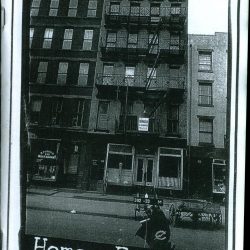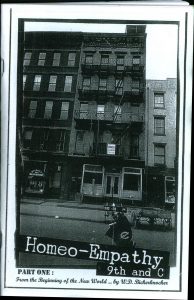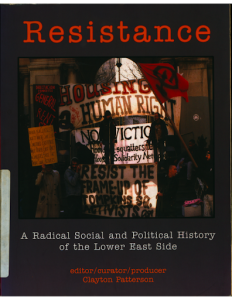July — Radical Community Part 2 of 4: Housing Initiatives

by John C. Harris
July 5 2021
Housing is among the most contentious subjects within the Lower East Side. Given that, and because the museum is located in the storefront of a former squat, our exploration of radical neighborhood spaces will begin with a few squats. According to Amy Starecheski, whose Ours to Lose plays a key role in our institutional library, the squats of the Lower East Side were unique to others in the city because, generally, their goal was not merely legal ownership of the space but also to provide solutions to problems that faced the neighborhood.
C-Squat, our commensal home, is no different. The zine Homeo-Empathy, within the Zine library at MoRUS, tracks the history of 155 Avenue C. It determines that the structure was squatted in as early as 1978 when, like many other squats, the city took over ownership of the building and failed to evict the tenants of the previous landlords. The building was known as El Plagote, a moniker referencing the state of the neighborhood at the time. Eventually the underground “Spanish social club” which served the community’s largely Latino and Black residents was shut down. The last residents were evicted and 155 Avenue C was once again one of many abandoned buildings in the Lower East Side. As the city rebounded from its economic crisis, the same abandoned buildings were considered up for grabs for speculative real estate developers. In response the Joint Planning Council was formed by more than thirty housing and community groups with the goal of protecting the neighborhood fro the wave of opportunistic development coming in the mid to late eighties. Squatters clamored into buildings as a new wave of homesteaders. In July of 1989, the building became known officially as C-Squat under new occupation. Since then, C-squat has evolved into a Co-Op owned by its residents and provides many services to the community ranging from a space to challenge the city’s exploitative encroachment, a renowned music venue within the punk scene, and the very building that allowed MoRUS to actively engage in the preservation and promotion of the history of activism within the Lower East Side.

(Homeo-Empathy 9th and C, W.D. Bickerknocker, MoRUS Zine Library)
Another squat with a trajectory similar to that of C-Squat is Umbrella House at 21-23 Avenue C. As early as 1984 the building was squatted by indigenous people who were, and continue to be, an extreme minority in New York City. They were eventually evicted and in 1988 another group began to occupy the space. The building opened again as Umbrella House and since its earliest days as a safe space for that uniquely marginalized group of people, it has, as Starecheski asserts, evolved into an iconic space with a mission rooted in the European tradition of squats by providing a commitment to the democratic process within the building as catalyst to carry out social justice work. It too became a Co-op in 2010 and among the many initiatives the space is committed to, it has engaged with alternative urban design perhaps most notably by installing a green roof in the form of a 820 square foot cultivable garden.
Many buildings have been squatted within the Lower East Side. Today, eleven of the formally declared squats from the 1980s remain in the neighborhood as Co-Ops. For decades these spaces have continued to provide platforms to challenge the status quo and limited exploitative corporate encroachment through the notion of “adverse possession” a concept that Raphael Bueno expands on within Seth Tobocman’s War in the Neighborhood and in an interview by Arron Jaffee within Clayton Patterson’s Resistance: A Radical Social and Political History of the Lower East Side both of which are held by MoRUS. However a squat does not just have to be a home. As we will see in the next segments of this series highlighting the radical network within the Lower East Side, a squat may be an agricultural site, community center, or art space.

(Resistance, edited by Clayton Paterson, MoRUS Institutional Library)
Part Three: Solutions to the Lack of Open Space and Food Inequity coming next week!
